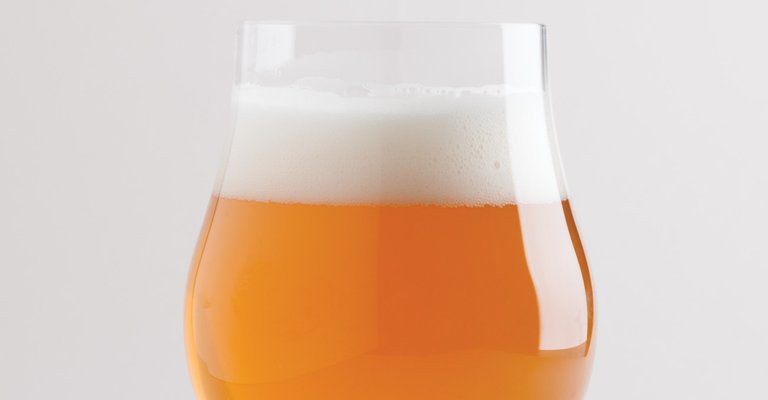
Belgian Golden Strong Ale can be devilishly tricky to make (see what I did there? Last “devil” pun, I promise). Like a lot of simple-recipe beers, there’s a risk that this turns out either boring (possible) or one-note (likely). The best versions of the style, though, make you sit up straight, look at the glass, and remind yourself that simple – done well – can be really, really satisfying. It’s not just a stripped-down version of Belgian Tripel, though it has that reputation. Instead, Belgian Golden Strong is more like a race car: Spartan, functional, and high-performing. If you make this and get something that’s good for getting drunk but not for pairing with food, then you’re letting one of the world’s great beer styles just pass you by.
STYLE
The Belgian Golden Strong is a strong, pale Belgian style. From a style perspective, though, it can be tough to differentiate because it bears some superficial and structural similarities to Belgian Tripel. It’s pale in color, highly carbonated, relatively high in alcohol, features some interesting fermentation characteristics, and finishes relatively dry. Wait, how is this not a Belgian Tripel? Oh, right: because it’s all of those things, but pushed a little more to their edges. Pale? Yes – but almost bone white, especially given the ABV. Dry? Yes – but with an emphasis on the bitter and not the spicy. Highly carbonated? Yes – but bordering on spritzy and overly-carbonic.
I don’t even like using Tripel as a starting point – this style is much more reminiscent of the kinds of stripped-down German Pilsners you can get, where you’d say, “OK, it’s got a lot in common with Czech Pilsner, but…” Simpler, sharper, and starker is the name of the game here, even in the presence of a very active fermentation and plenty of alcohol complexity.
RECIPE
You (and/or your local home brew shop grain manager) are going to love this one: twelve pounds of Pilsner malt. Done. And not that fancy floor-malted stuff, either: it’s rich and complex, but we’re not really looking for much (any) malt character here. I mean, you can do it that way, but I don’t, and I don’t think the style supports it. To that we add three pounds of either cane sugar or the equivalent amount of a pure white Belgian candi syrup or sugar. It’s all going away, anyway, so the source doesn’t really matter – we just want the gravity points. This should give you a beer that’s only about 3.5-4 on the SRM scale. It’s really, really pale. This is also useful for detecting oxidation: if you brew this, pour it, and it’s gold in color, you probably have a stale bottle on your hands.
Hopping is, likewise, pretty simple: 30 IBUs of just about anything, right at the top of the boil, will be fine. I’d avoid the obviously American, citrusy hops, just in case any of that flavor or aroma survives, but it’s going to be pretty minimal.
Finally, for yeast I like the Wyeast 3711, French Saison. I know this isn’t a Saison, but everything I want – a really dry fermentation, spice, and some fruit – is produced by this strain. If it has a fault, it’s that it doesn’t produce the kinds of pear-and-apricot esters I love, but if that’s not your particular fascination in Belgian styles, you probably won’t miss it. If it is, though, you can do what I do: pitch a blend of French Saison and Belgian Ardennes (3522), and sit back and enjoy!
PROCESS
Go ahead and mash normally, here. You’re going to get a ton of drying from the simple sugar additions, so there’s no particular reason to get cute with fermentation temperature.
Now, when it comes to the boil, I say go ahead and get cute. You don’t need a full 90-minute boil to drive off DMS, but I give it an extra ten minutes or so (to 70 minutes), just in case.
I’ve lost track of how many times I’ve written this, but this beer is made in the fermenter. Start low, at about 62F, but start to immediately raise the temperature: I tweak my temp controller up by one degree Fahrenheit per day until I reach 80F or as high as it will go, whichever comes first. To avoid hot alcohols or cidery flavors, you don’t want to start too high. To avoid a sweet, syrupy beer (or, worse, bottle bombs), you want to push the temperature nice and high to encourage a complete attenuation of your simple sugars. Trust your yeast(s), though: you’ll get plenty of flavor out of them.
High, high carbonation is desirable here, too. It’s going to help give you that impression of dryness and balance the alcohols, and it’s a great palate-scrubber!
IN CLOSING
You should end up with a bright, dry, flavorful strong ale that actually can be consumed by the pint (though you should probably limit yourself to just one or two!). If you don’t like what you’re getting, consider a change in yeast strain and/or reduce carbonation a bit, and double-check your color to see if you’re getting too much oxygen pick-up somewhere along the line. Oxidation can be a killer here, and BGS should always seem fresh, so store it well and avoid oxygen along the way. The devil’s in the details! Sorry. Had to have just one more.
Good post, thanks for that. I am also writing about beer, so If you are interest, you can take a look at my blog.
Hi! I am a robot. I just upvoted you! I found similar content that readers might be interested in:
https://beerandbrewing.com/make-your-best-belgian-golden-strong-ale/